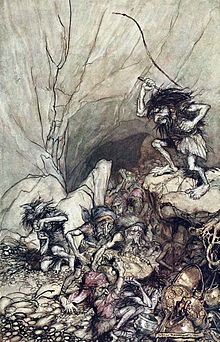
The Völsunga saga is a legendary saga, a late 13th-century prose rendition in Old Norse of the origin and decline of the Völsung clan. It is one of the most famous legendary sagas and an example of a "heroic saga" that deals with Germanic heroic legend.

The Nibelungenlied, translated as The Song of the Nibelungs, is an epic poem written around 1200 in Middle High German. Its anonymous poet was likely from the region of Passau. The Nibelungenlied is based on an oral tradition of Germanic heroic legend that has some of its origin in historic events and individuals of the 5th and 6th centuries and that spread throughout almost all of Germanic-speaking Europe. Scandinavian parallels to the German poem are found especially in the heroic lays of the Poetic Edda and in the Völsunga saga.

Brunhild, also known as Brunhilda or Brynhild, is a female character from Germanic heroic legend. She may have her origins in the Visigothic princess and queen Brunhilda of Austrasia.
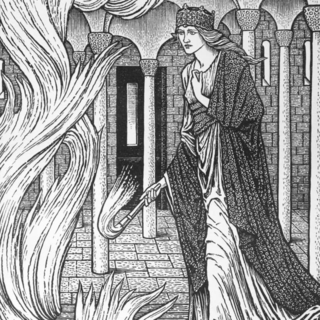
Gudrun or Kriemhild is the wife of Sigurd/Siegfried and a major figure in Germanic heroic legend and literature. She is believed to have her origins in Ildico, last wife of Attila the Hun, and two queens of the Merovingian dynasty, Brunhilda of Austrasia and Fredegund.

In German heroic legend, Alberich is a dwarf. He features most prominently in the poems Nibelungenlied and Ortnit. He also features in the Old Norse collection of German legends called the Thidreksaga under the name Alfrikr. His name means "ruler of supernatural beings (elves)", and is equivalent to Old French Alberon or Auberon.

Hagen or Högni is a Burgundian warrior in Germanic heroic legend about the Burgundian kingdom at Worms. Hagen is often identified as a brother or half-brother of King Gunther. In the Nibelungenlied he is nicknamed "from Tronje".

Gundaharius or Gundahar, better known by his legendary names Gunther or Gunnar, was a historical king of Burgundy in the early 5th century. Gundahar is attested as ruling his people shortly after they crossed the Rhine into Roman Gaul. He was involved in the campaigns of the failed Roman usurper Jovinus before the latter's defeat, after which he was settled on the left bank of the Rhine as a Roman ally. In 436, Gundahar launched an attack from his kingdom on the Roman province of Belgica Prima. He was defeated by the Roman general Flavius Aetius, who destroyed Gundahar's kingdom with the help of Hunnish mercenaries the following year, resulting in Gundahar's death.

Gjúki was the King of the Burgundians in the Germanic heroic legend. He was a member of the Niflungar family, and the father of Gundomar I, Giselher and Gunther.

Guðrúnarkviða II, The Second Lay of Gudrún, or Guðrúnarkviða hin forna, The Old Lay of Gudrún is probably the oldest poem of the Sigurd cycle, according to Henry Adams Bellows.
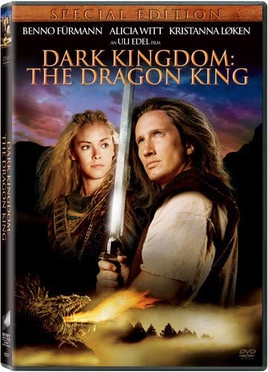
Dark Kingdom: The Dragon King is a 2004 German television film directed by Uli Edel and starring Benno Fürmann, Alicia Witt, Kristanna Loken and Max von Sydow. The film is based on the Norse mythology story Völsungasaga and the German epic poem Nibelungenlied, which tells the mythological story of Siegfried the Dragon-Slayer. Richard Wagner's music dramas Siegfried and Götterdämmerung are based on the same material. Dark Kingdom: The Dragon King was written by the husband and wife team of Diane Duane and Peter Morwood and is a Tandem Communications production. It was filmed entirely in South Africa.

Die Nibelungen is a two-part series of silent fantasy films created by Austrian director Fritz Lang in 1924, consisting of Die Nibelungen: Siegfried and Die Nibelungen: Kriemhild's Revenge.
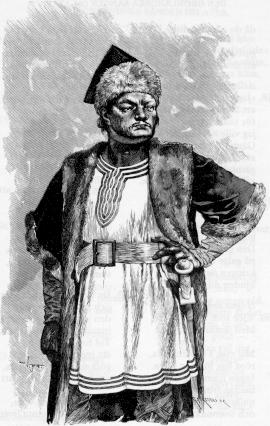
The Dráp Niflunga is a short prose section in the Poetic Edda between Helreið Brynhildar and Guðrúnarkviða II. Henry Adams Bellows notes in his commentary that the purpose of the section is to serve as a narrative link between the poems.

Atlamál in grǿnlenzku is one of the heroic poems of the Poetic Edda. It relates the same basic story as Atlakviða at greater length and in a different style. The poem is believed to have been composed in Greenland, most likely in the 12th century. It has 103 stanzas and is the only Eddic poem written entirely in the metre málaháttr.

Sigurðarkviða hin skamma or the Short Lay of Sigurd is an Old Norse poem belonging to the heroic poetry of the Poetic Edda. It is one of the longest eddic poems and its name derives from the fact that there was once a longer Sigurðarkviða, but this poem only survives as the fragment Brot af Sigurðarkviðu.

Sigurd or Siegfried is a legendary hero of Germanic heroic legend, who killed a dragon—known in some Old Norse sources as Fáfnir—and who was later murdered. It is possible he was inspired by one or more figures from the Frankish Merovingian dynasty, with Sigebert I being the most popular contender. Older scholarship sometimes connected him with Arminius, victor of the Battle of the Teutoburg Forest. He may also have a purely mythological origin. Sigurd's story is first attested on a series of carvings, including runestones from Sweden and stone crosses from the British Isles, dating from the 11th century.

The Legend of Sigurd and Gudrún is a book containing two narrative poems and related texts composed by English writer J. R. R. Tolkien. It was published by Houghton Mifflin Harcourt and HarperCollins on 5 May 2009.

Die Nibelungen is a 1966/1967 West German fantasy film released in two parts, Siegfried von Xanten and Kriemhilds Rache. It was directed by Harald Reinl and produced by Artur Brauner. Die Nibelungen starred Uwe Beyer, Karin Dor and Herbert Lom. The two films were a remake of Fritz Lang's 1924 silent classic Die Nibelungen, which was in turn based on the epic poem the Nibelungenlied.

Das Nibelungenlied is a novel by German writer Albrecht Behmel about the medieval epic of the same name. The story follows the Middle High German original.

Das Lied vom Hürnen Seyfrid, or Hürnen Seyfrid for short, is an anonymous Early New High German heroic ballad. The poem concerns the adventures of young Siegfried, hero of the Nibelungenlied and an important figure in Germanic heroic legend. It preserves traditions about Siegfried that are otherwise only known from Old Norse sources and thus attest their existence in oral traditions about Siegfried that circulated outside of the Nibelungenlied in Germany.
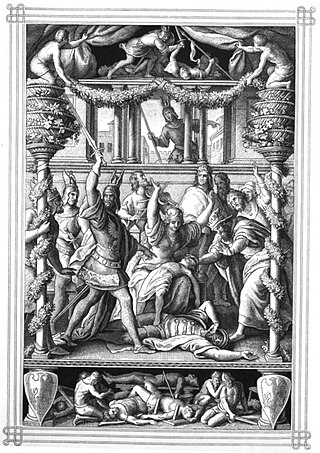
Ortlieb is the son of Kriemhild (Gudrun) and Etzel (Atli) and a minor figure in Germanic heroic legend and literature.
